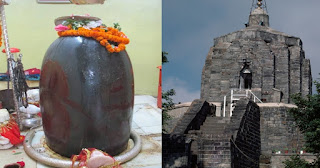Sankaracharya Temple
Srinagar our first stopover point in our Amarnath yatra was Srinagar. The date is 1st July and we landed at 11.30. Walking out of airport it isn't the pleasant weather that we expected but it was hotter than Madras. Got on the car and it was straight drive to Shankaracharya Temple - our very first stop on our pilgrimage. What better way to start the yatra with the blessings of Lord Siva.
Shankaracharya Temple or Jyeshteshwara Temple is a Hindu temple situated on top of the Shankaracharya Hill on the Zabarwan Range in Srinagar, Jammu and Kashmir, India. It is dedicated to Lord Shiva. The temple is at a height of 1,000 feet (300 m) above the valley floor and overlooks the city of Srinagar.
The structure is considered as the oldest temple in Kashmir, historically and traditionally. It is situated on a hill that is a well preserved Panjal trap formed by Permian era volcanic activity. There is no consensus with regard to an exact date of construction
The earliest historical reference to the hill comes from Kalhana. He called the mountain 'Gopadri' or 'Gopa Hill'. Kalhana says that King Gopaditya granted the land at the foot of the hill to the Brahmins that had come from the "Aryadesa". The land grant, an agraharam, was called 'Gopa Agraharas'. This area at the base is now called Gupkar. Kalhana mentions another village in the vicinity of the hill where King Gopaditya housed some of the Brahmins to a village next door in present-day Galgate. Kalhana also mentions that King Gopaditya built the temple on the top of the hill as a shrine to Jyesthesvara (Shiva Jyestharuda) around 371 BCE.
While the associated history dates to 371 BCE, K. Warikoo, a professor at a centre of JNU's School of International Studies, places the present re-constructed structure of temple to the 6th century CE. In 1899 James Fergusson placed the temple construction to the 17th to 18th century. Fergusson disputes claims that structures on the basis of which he makes this claim are from repairs. Aurel Stein while agreeing that the superstructures are from a more recent date, places the base and the stairs as much older. Historical figures associated with the monument include Jaloka, one of the sons of Ashoka (Gonandiya), according to the Rajatarangini
Kashmiri Hindus strongly believe the temple was visited by Adi Shankara (8th century CE) and has ever since been associated with him; this is how the temple and hill got the name Shankaracharya. It is here that the literary work Soundarya Lahari was composed. It was composed by Adi Shankara after accepting the major faith in the region at the time, that of Shakti, and that the union of Shiva and Shakti, as in Shaktism, transpired into the symbolism of the Sri Yantra
Starting the climb
Shivling
The small cave












Comments